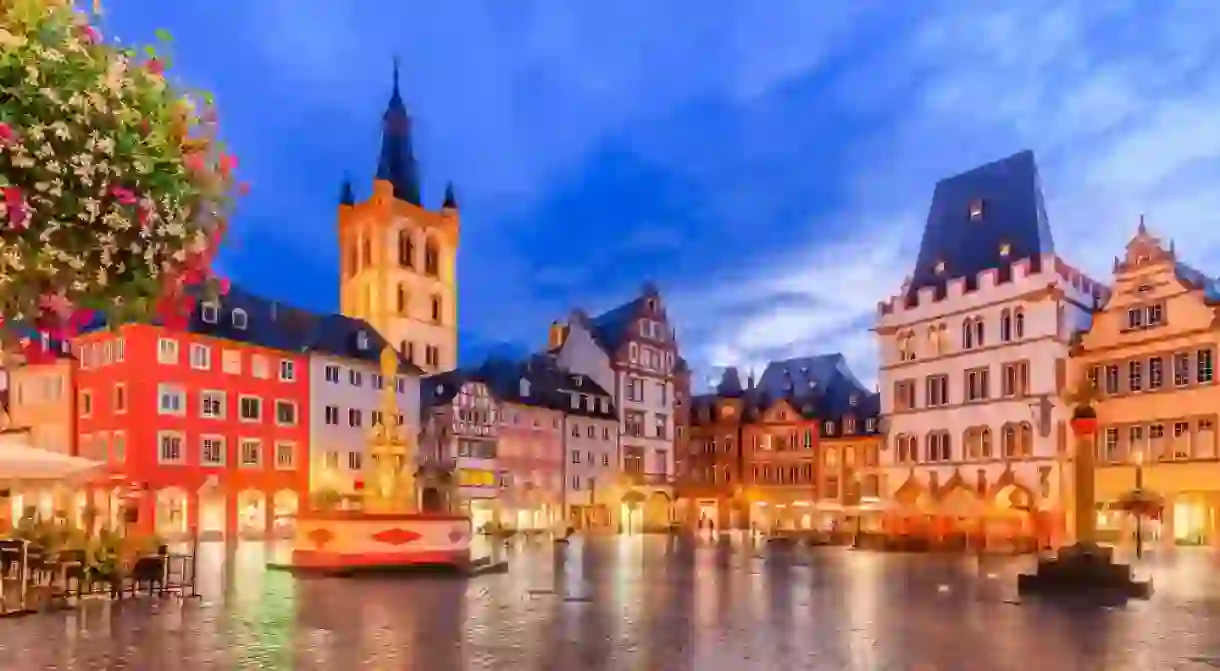10 Unmissable Things to See and Do in Trier, Germany

Trier is up there with Germany’s oldest cities and boasts a number of sites which date back to the Roman Empire, earning it its nickname ‘Rome of the North’. The ancient sites boast the UNESCO World Heritage flag but are not the only reasons to visit this charming city – fantastic food, award-winning wines, a medieval town centre and Karl Marx’ birthplace add to the mix. Here are the top 10 things to do and see in Tier.
Porta Nigra
Architectural Landmark

Trier’s most famous landmark will set you in awe. The Porta Nigra (black gate) was erected around 180 AD and today is the best preserved Roman city gate north of the Alps. Composed of 7.200 gigantic sandstone block, the solid structure survived centuries of repurposing and reconstruction and in its time served as the residence of Saint Simeon of Trier in the 11th century and after his death was used as a church. In 1803, Napoleon ordered the Porta Nigra to be restored to its original form.
The Basilica of Constantine
Architectural Landmark, Historical Landmark
Also known as Aula Palatina, the basilica was commissioned as a throne room by emperor Constantine I who reigned over the Roman Empire between AD 306 and 337. Frederick William IV of Prussia repurposed the room as a Protestant church and measuring 67 metres (219 ft) in length, and with a 33-metre-high (108 ft) ceiling, the room still wows people today. Up to 1.300 people flock the to the ancient built for church services today.
Amphitheatre
Architectural Landmark

During antiquity, the Trier amphitheatre provided entertainment for the masses. Some 18.000 spectators squeezed on the stands to view bloody fights between gladiators and animals, but the arena was also used for gatherings and religious celebrations. Archaeological excavations unveiled the cellar rooms in 1908, and today visitors can explore the arena, theatre ranks and the cages and rooms where animals and men waited before the fights.
Imperial Baths
Architectural Landmark, Historical Landmark
Trier quickly grew to be an important commercial town, and in the late antiquity epoch was declared to be the imperial residence. Plans for a palace district included the late 3rd-century construction of the Imperial Baths, meant as a gift to the public. But the build was put on hold and only completed approximately 100 years later to serve as barracks for the Imperial guard. Over the course of history, the ancient building was used as a fortress, city wall and monastery. Today’s tours allow you to explore the ruins of the palace district both under and overground.
Trier Cathedral and Treasury
Historical Landmark, Architectural Landmark

The imposing Trier Cathedral – Germany’s oldest bishop’s church – boasts 1,700 years of history and the architectural mix of Gothic, Baroque and Romanesque elements of Trier Cathedral testify to its past. The interior bears noteworthy ecclesiastical relics and the treasury holds a collection of art from the late antiquity to the 20th century, medieval manuscripts and liturgical garments.
City Museum Simeonstift
Museum
Barbara Baths
Architectural Landmark
When construction of the monumental baths was completed in the 2nd century AD, Trier’s Barbara Baths were the second largest baths in the entire Roman Empire. Encompassing a jaw-dropping 42.000 square metres (452,000 square feet), the complex featured a top-notch spa and wellness facilities at the time, including several heated pools, beauty salons, restaurants, a cultural centre and a library. Findings show that the interiors were decked out in marble and alcoves were designed to replicate grottos and caverns. A boardwalk was constructed above the remains and an information panel tells visitors everything they need to know about the history and features of the complex.
Wine Tasting
Architectural Landmark

With the Moselle valley being just around the corner, Trier is a great spot to sample some of Germany’s award-winning Rieslings. If you don’t have time to venture out to the vineyards in the countryside, Trier’s wine bars and restaurants can help you out. Weinstube Kesselstatt is conveniently located in the city centre and serves regional dishes and award-winning wines. For a gourmet dining experience, make reservations at the twin-Michelin-starred Becker’s Restaurant in Trier’s south.
Hauptmarkt
Market

When Trier gained market rights in 958, the old town market square marked the city centre, and even today it is the gateway to some of Trier’s most notable sights, including the cathedral and the Jewish quarter. The old townhouses around make up a postcard-perfect scenery, but two buildings stand out from the crowd. The white facade and grey-shingled roof of the ‘Steipe’ have opposed Trier’s cathedral since 1483 and once housed the city council and notabilities. The next door red house dates back to 1684 and features inscriptions claiming that Trier is 1.300 years older than Rome.
Karl Marx House
Architectural Landmark, Historical Landmark
The father of communism and writer Karl Marx was born in Trier in 1818. His birthplace in Brückengasse 10 now houses a museum dedicated to his life from his upbringing in Germany to his death in exile in London at the age of 64, as well as his disruptive theories and concepts and their influence on the world up until today. The museum is currently undergoing refurbishment and will reopen its doors in early May 2018.
Germany Trips and Tours
Architectural Landmark
Planning a trip to Germany? If you want to see as many of the sights on this list as possible, you’re best off booking a multi-day trip to make the most out of your trip.













